Expert Tips for Stain Removal from Velvet Fabric
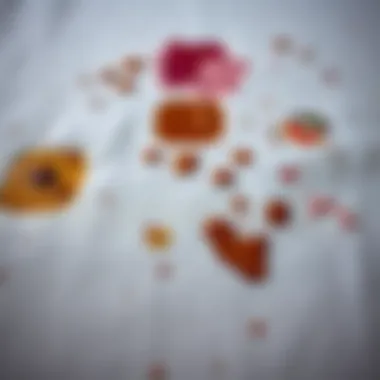
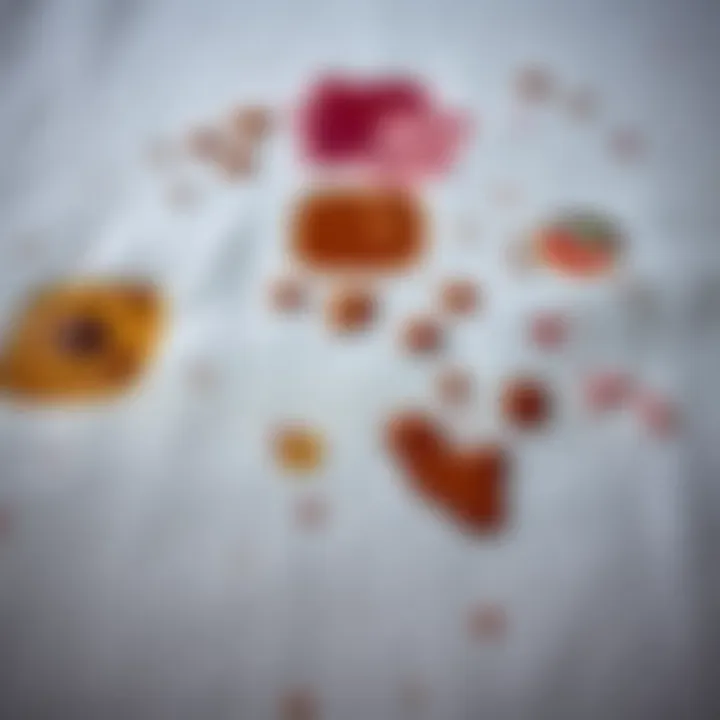
Intro
Velvet, with its lush texture and rich colors, has long been a staple in the world of textiles, finding its way into everything from opulent drapes to sophisticated upholstery. However, its beauty comes with a cost; it can be quite the challenge when it comes to upkeep, especially when stains find their way onto its delicate surface. This guide aims to arm homeowners and interior design aficionados with the right tools and techniques for managing and erasing these pesky blemishes without sacrificing the fabric's unique allure.
Understanding the nature of velvet and its various types is crucial before delving into the world of stain removal. Each type of stain behaves differently, meaning one might encounter anything from a splash of red wine at a dinner party to mud tracked in from a garden. Knowing how to treat these stains effectively is key to maintaining the fabric’s beauty. This comprehensive guide will walk you through various approaches tailored specifically for velvet, ensuring that your cherished pieces remain as striking as the day they adorned your home.
Design Inspirations
Embracing velvet can extend beyond just functionality. It can become a centerpiece of design inspirations in any space. The elegance of velvet is noteworthy, and it opens up avenues for creative decor choices.
Trending Styles
Currently, interior design has seen a resurgence of rich, jewel-toned velvets paired with equally vibrant hues in accompanying decor elements. Think emerald greens and deep blues lit up by warm gold accents and soft whites. Many designers are pushing the envelope with innovative combinations that invite curiosity and draw the eye. Velvet chairs and sofas are often used as accent pieces, injecting a sense of drama into neutral spaces. The technique of layering textures is also at the forefront; velvet cushions atop wool or cotton bring in visual interest while creating a cozy atmosphere.
Color Palettes
When selecting color palettes featuring velvet, consider those that create a mood. Soft pastels can evoke calmness, while rich, dark colors instill a sense of opulence. Popular combinations include:
- Navy and Blush: Deep, dramatic tones mixed with light, airy shades.
- Emerald and Mustard: A bold pairing that energizes any room.
- Dusty Rose and Grey: A softer, romantic touch that keeps the vibe light.
These palettes work exceptionally well in various contexts, making velvet a versatile fabric that complements multiple design themes – from contemporary chic to classic elegance.
In the next sections, we will discuss practical methods for stain removal, incorporating effective strategies to maintain the integrity and beauty of your velvet upholstery or garments.
Understanding Velvet Fabric
Understanding velvet fabric is pivotal to effectively removing stains and maintaining its luxurious appearance. Velvet, with its rich texture and sheen, is often a prized addition to homes, whether in the form of upholstery, drapery, or garments. It evokes a sense of elegance, making it a popular choice for both interior design enthusiasts and those who appreciate high fashion.
The fabric is characterized by its distinct soft pile, which is created by cutting the loops of the fabric in a specific manner. This not only gives it a unique feel but also contributes to its ability to absorb light, resulting in an alluring depth of color that can be hard to replicate with other materials. However, with this beauty comes a bit of complexity, particularly when it comes to cleaning and caring for velvet.
In this article, we will explore various stains that can afflict velvet, the appropriate methods of removal, and preventive measures to keep it looking splendid. Understanding the fabric itself lays the foundation for employing the right cleaning techniques tailored to retain its texture and vibrancy.
Characteristics of Velvet
Velvet is notable for several key characteristics:
- Softness: The plushness of velvet is unparalleled. It feels luxurious against the skin and creates a comfortable atmosphere when used in home decor.
- Durability: When treated properly, velvet can be surprisingly resilient. It withstands wear well, especially in high-traffic areas.
- Varied Pile Lengths: Velvet may come with different pile lengths, and this affects how it looks and feels. Short pile velvet has a sleek appearance, while long pile velvet offers more texture.
- Versatile Color Range: Velvet can be dyed in a myriad of colors, making it suitable for any design scheme. The color tends to appear deeper and more saturated due to the fabric’s structure.
However, velvet also comes with certain care requirements to keep it looking pristine. It's sensitive to water stains, can trap dust and dirt, and might require specialized cleaning solutions for stain removal.
Common Uses of Velvet
Understanding where velvet is commonly used helps to identify potential stains and the urgency of cleaning needs. Some of the common uses of velvet include:
- Upholstery: Velvet is often used in sofas, chairs, and cushions, bringing sophistication to living spaces.
- Curtains and Drapes: For those wanting to enhance the aesthetic appeal of their windows, velvet drapery adds both warmth and a dramatic flair.
- Fashion: Velvet garments, such as dresses and blazers, are sought after for their touchable texture and rich colors.
- Accessories: Items like pillows, throws, and bags made from velvet offer a tactile charm that elevates any ensemble.
By being aware of how and where velvet is applied, homeowners and designers can make informed decisions about cleaning and maintenance, ensuring their treasured velvet pieces remain in tip-top shape.
Types of Stains on Velvet
Understanding the types of stains that can affect velvet fabric is crucial for any homeowner or interior design enthusiast. Velvet, known for its luxurious texture and intricate pile, can be particularly susceptible to staining from a multitude of sources. Each type of stain behaves differently, which necessitates tailored removal techniques. Knowing the distinctions helps in choosing the right cleaning method and ultimately preserving the fabric’s beauty and longevity. This section explores common stains found on velvet, breaking them down into categories and discussing the specific considerations for each.
Food and Beverage Stains
Food and beverage stains are perhaps the most common offenders when it comes to velvet, often resulting from spills during gatherings or casual meals. Items like wine, coffee, or greasy snacks can create unsightly marks that mar the rich surface of velvet. The sugary or acidic nature of these stains can further complicate removal, as they may set quickly if not dealt with promptly.
It is essential to act fast when a spill occurs. Gently blot the area with a clean cloth to absorb as much liquid as possible, without rubbing, which can embed the stain further into the fabric. After you’ve blotted, a specially formulated velvet cleaner or a mild soap diluted with water can work wonders. Test any cleaning solution in a hidden spot first to avoid discoloration.
Ink and Dye Stains
Ink and dye stains present a unique challenge for velvet. Markers, pens, and even colored clothing may leave behind vivid stains that are often more permeant than food or drink. Their chemical compositions can interact adversely with the fibers, creating a sort of lock that firmly attaches the stain to the fabric.
When dealing with ink stains, it is crucial to refrain from rubbing, as this can expand the affected area. Instead, place a paper towel or clean cloth beneath the stained area and use an alcohol-based product or a specialized ink remover, applying it sparingly. Remember to dab lightly, allowing the solution to lift the stain without disturbing the velvet’s pile too much.
Oil and Grease Stains
Oil and grease stains can stem from various sources such as cooking oils, lotions, or even the residue from food items. These stains can be particularly stubborn, as the oily nature tends to latch on to the delicate fibers of velvet. Because moisture can sometimes make these stains worse, it’s best to avoid adding water or liquid cleaning solutions initially.
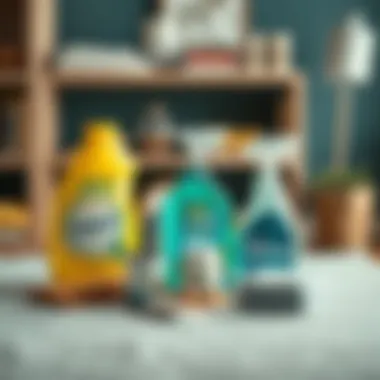
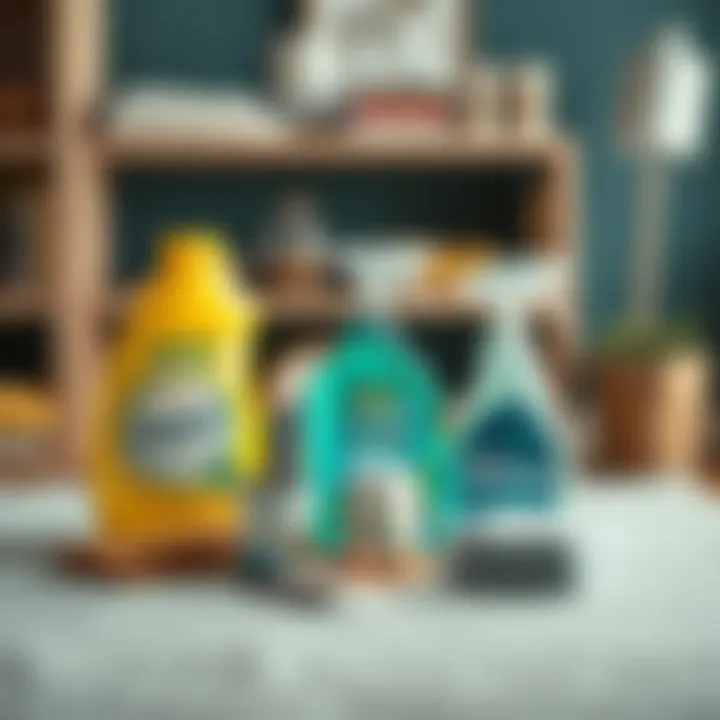
Instead, try to absorb excess oil with a dry cloth or paper towel, and then sprinkle a bit of cornstarch or talcum powder over the stain. Let it sit for a few hours or overnight, as this can draw out the grease. Afterward, gently brush off the powder and use a mild detergent solution or a specialized cleaning product if necessary.
Water Stains
While it might seem paradoxical, water stains can also be problematic for velvet. These stains might result from accidental spills of clear liquids or moisture from the environment. They can lead to rings or discoloration, impacting the overall appearance of the fabric.
The first step with water stains is to gently blot the area to remove excess moisture. However, do take care not to rub, as this may further set the stain. A fabric steamer can sometimes be used cautiously to refresh the pile, but if the stain persists, consider using a soft cloth dampened with white vinegar, as it can help neutralize the stain.
"Understanding the intricacies of stain types can save not just your velvet fabric, but a lot of heartache as well."
Knowing the kinds of stains that velvet is prone to lets you be proactive about cleaning and maintenance. Taking immediate action can make all the difference in preventing a permanent mark from ruining your fabric's allure. By employing the proper techniques tailored to each stain type, one can uphold the elegance and dignity of velvet for years to come.
Preparation for Stain Removal
Before tackling the unique challenges associated with removing stains from velvet, it’s crucial to prepare adequately. The preparation phase sets the stage and can drastically improve your chances of a successful cleaning outcome. Velvet fabric, known for its lush texture and beauty, is also sensitive. Any missteps during the cleaning process can damage its appearance, so a bit of planning is essential.
When you're faced with a messy situation, the importance of preparation cannot be overstated. Properly preparing for stain removal not only increases the effectiveness of your cleaning methods but also helps in preserving the quality and integrity of the velvet fabric. This way, you’re not just throwing caution to the wind; you’re acting with intention and knowledge.
Gathering Necessary Supplies
To begin, you’ll need to gather the right supplies; it’s like assembling your toolkit for a home project. Each cleaner has its purpose, and having them on hand can make the process feel systematic rather than chaotic. Here’s a list of some essential supplies:
- Soft cloths or paper towels: These are gentle enough not to damage the fabric while being effective at soaking up spills.
- Mild detergent: A soft detergent can work wonders when mixed with water for spot cleaning.
- White vinegar: A natural cleaning agent that helps lift stains while avoiding harsh chemicals.
- Baking soda: Great for absorbing odors and absorbing greasy stains.
- Brush with soft bristles: After cleaning, this can restore the velvet’s texture without causing damage.
Having these items close by can feel like a safety net, allowing you to focus on the task at hand without scrambling to find what you need.
Testing Cleaning Products
Once you’ve gathered your supplies, the next important step is to test the cleaning products on a small, inconspicuous area of the velvet. This testing phase might seem tedious, but it’s worth every minute. Different fabrics can react unpredictably to certain cleaning agents.
"The only way to know if a product will hurt your velvet is to first give it a test run on a hidden spot."
You don’t want to find yourself in a situation where a cleaner causes discoloration or further damage.
To conduct this test:
- Choose an area that’s not easily visible—think inside a cushion cover or the back of a chair.
- Apply a small amount of the cleaner with a soft cloth.
- Wait a few minutes to observe any reaction.
- Evaluate the area for any fading or discoloration after it dries.
If all's well, you can proceed with confidence. If not, it’s back to the drawing board to find an alternative solution.
Preparing for stain removal is about more than just gathering items and testing products; it’s about setting a solid foundation for maintaining the quality and look of velvet over time. By ensuring that you have what you need, along with knowledge about how to use those cleaning agents, you greatly enhance your chances for success.
Methods for Removing Stains from Velvet
Removing stains from velvet demands an understanding of the delicate nature of the fabric. When addressing any stain, the first impulse might be to scrub it away. However, velvet has a unique texture that can easily be damaged if subjected to vigorous cleaning methods. Therefore, knowing the right techniques is vital not only for effective stain removal but also for protecting the fabric's integrity.
Applying the correct method can mean the difference between a restored elegance and the possibility of irreversible damage. Each technique has its particular benefits, and combining methods may sometimes yield better results than relying solely on one. Furthermore, understanding which stains are best suited for which methods can help homeowners and design enthusiasts alike to make informed choices and maintain their velvet items in pristine condition.
Blotting Technique
The blotting technique is one of the simplest yet most effective ways to deal with stains on velvet. This method involves pressing a clean cloth or paper towel against the stain instead of rubbing it. Rubbing can push the stain deeper into the fabric and alter the texture of the velvet significantly.
To properly use this technique:
- Use a white cloth to avoid any color bleeding from the cloth itself.
- Dab the stain gently, starting from the outer edges and working inwards to prevent the stain from spreading.
- Repeat until the cloth is no longer absorbing any more of the stain.
This technique works especially well with liquid stains like wine or coffee, where quick action is necessary. It's a straightforward approach that requires minimal supplies and provides a gentle way to handle delicate fabrics.
Dabbing with Cleaning Solutions
After blotting, if the stain remains, applying a suitable cleaning solution can be the next crucial step. This involves using a cleaner specifically designed for velvet or a gentle detergent mixed with water. Before using a new product, always test it on a hidden area of the fabric to ensure there is no adverse reaction.
To implement this:
- Mix the cleaning solution with water in a bowl.
- Using a clean cloth, dip it into the solution and wring it out until it’s damp, not soaking wet.
- Dab the stained area, repeating the process until the stain starts to lift.
Avoid soaking the fabric, as excessive moisture can lead to further damage. This method is particularly useful for stubborn stains and helps in maintaining the velvet's soft feel.
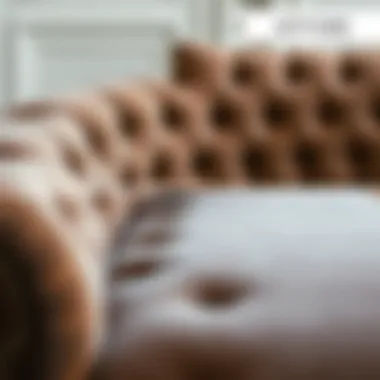
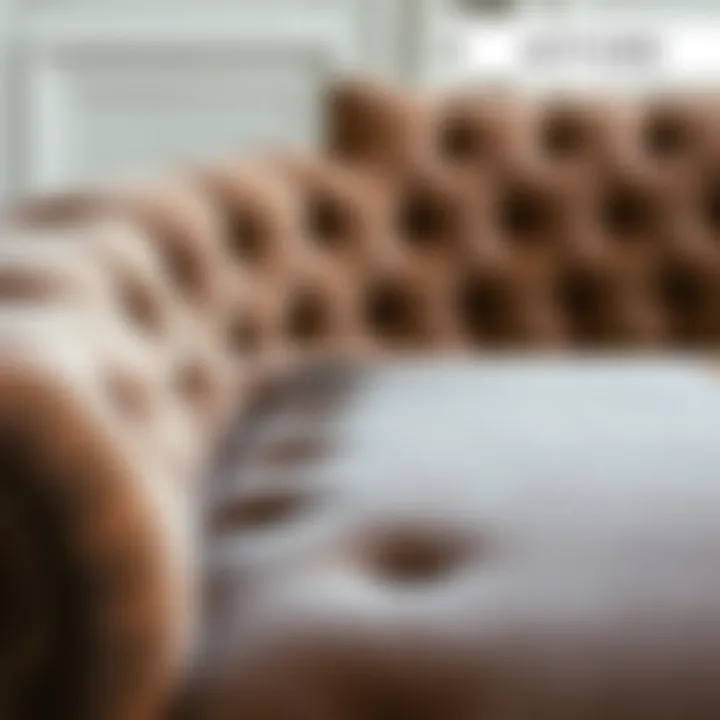
Using a Steam Cleaner
For those who might find manual methods a bit tedious, a steam cleaner can simplify the process. This tool is effective for loosening up dirt and stains embedded within the fibers of the fabric.
When using a steam cleaner:
- Maintain a safe distance between the nozzle and the velvet to prevent scorching.
- Move the steamer around the stained area instead of concentrating on one spot.
- Use the steam in short bursts, allowing the warm air to penetrate the fabric and break down any grime.
This method can revitalize not just stained areas but also the overall texture of the velvet, giving it a fresh, new look without additional scrubbing.
Professional Cleaning Services
Sometimes, stains can be beyond the reach of home techniques, especially for deep-set or large stains. In these cases, considering professional cleaning services might be wise. Experts have access to specialized cleaning products and equipment designed specifically for handling delicate fabrics like velvet.
When opting for this choice:
- Look for reputable cleaners who understand velvet's unique requirements.
- Ask about their methods and whether they use gentle, fabric-safe products.
This not only saves time and effort but also ensures that your velvet pieces receive the best care possible, preserving their beauty for years to come.
"A stitch in time saves nine" – addressing stains promptly is key in maintaining velvet's luxury feel.
By employing these methods, homeowners can effectively handle stain removal without compromising the exquisite nature of their velvet pieces. Each technique complements one another, ensuring a thorough approach to keeping velvet items looking immaculate.
Specific Stain Removal Techniques
Stains can tarnish the luxurious charm of velvet, one of the most elegant fabrics. Thus, mastering specific stain removal techniques is crucial in preserving its beauty. Each type of stain requires its own unique approach to ensure effective removal without compromising the integrity of the fabric. Addressing these stains promptly with correct methods helps maintain the velvety texture and appearance, avoiding the need for costly replacements or professional cleaning.
Removing Food and Beverage Stains
Food and beverage stains are common culprits on velvet. A tiny spill during a dinner party can quickly turn your lively gathering into a stain nightmare. To tackle such stains effectively, it’s vital to act fast. Start by gently blotting the area with a clean, dry cloth to absorb any excess liquid. Never rub; this may spread the stain, making it worse.
If the stain persists, you can concoct a simple cleaning solution. Mix equal parts of white vinegar and water. Dab the solution onto the stain using a soft cloth. The vinegar acts not only to lift the stain, but also neutralizes odors that may linger. After treating, ensure to blot with cold water to remove any vinegar residue. Following these steps can mean keeping your velvet looking brand new.
Treating Ink Spots
Ink stains on velvet could be considered the ultimate nightmare for fabric lovers. The vibrant colors of ink can be deceitful; they seem to seep right into the fabric. When faced with ink, resist the temptation to rub, as it may spread the ink further. Instead, start by placing a paper towel under the stained area to trap excess ink.
Utilize rubbing alcohol by applying it to a clean white cloth, then gently dab the stain. A few drops can often do wonders. The alcohol interacts with the ink, breaking it down. Once you've treated the ink spot, rinse with a bit of cold water to eliminate any residual alcohol. It’s that simple, but patience is essential, as some spots may require repeating the process.
Dealing with Oil and Grease Marks
Ah, oil and grease marks! They know just how to slip into the fabric and ruin that perfect look. Whether it’s from cooking or a mishap at an upscale restaurant, dealing with these stains needs some finesse. The first step is to sprinkle some cornstarch or talcum powder directly on the stain. This helps absorb the oil.
Let it sit for at least 30 minutes to allow the powder to do its job. Following this, gently brush off the powder with a soft brush. If a shadow of the stain remains, a bit of dish soap mixed with water can be applied lightly with a sponge. Always remember to sponge upward from the lower side of the stain to avoid spreading. Rinse accordingly and allow it to air dry. Treating oil promptly ensures that it does not settle in, keeping your velvet in stellar condition.
Handling Water Stains
Surprisingly, water stains can be just as troublesome as any other type of stain on velvet. These spots can leave random marks that mar the fabric's luxuriousness. To remedy water stains, first, check if any residual moisture is still present on the fabric. If so, gently blot with a dry cloth. To prevent the stain from becoming permanent, you can steam the area lightly.
Hold a steamer about six inches away and allow the steam to glide over the stains. This will help restore the pile and minimize the visibility of marks. Be sure not to soak the area to avoid causing more water stains. Once done, allow the fabric to cool down, then gently brush with a soft velvet brush to bring back its luster.
Important Note: Always remember that the best way to deal with stains is prevention. Regular maintenance and vigilance can save you many headaches down the line.
By grasping these specific techniques for various stains, you equip yourself with the know-how to protect your velvet treasures and maintain them for years to come. Who wouldn't want to keep such beautiful fabric looking pristine?
Post-Cleaning Care for Velvet
When you've wrestled with stubborn stains and finally tackled them, the next step is to ensure that the velvet retains its original beauty. Post-cleaning care is not just an afterthought; it's crucial for maintaining the fabric's plush texture and elegance. Velvet, being a delicate fabric, requires a gentle touch and attention to detail after any cleaning effort. This section will delve into the important aspects of post-cleaning care for velvet, helping you to keep your pieces looking their best for years to come.
Brushing Velvet Pile
After cleaning, it's beneficial to brush the velvet pile. This helps restore the fabric's natural look and feel. Its unique texture can easily fall flat during the staining process, leaving it lacking its signature depth. Using a soft-bristled brush, gently go over the surface in the direction of the nap. This action lifts the fibers, ensuring they stand tall and regain their luxurious appearance.
The brushing process also aids in removing any remaining detergent or residue, offering another layer of care. It's generally a good idea to brush more frequently for upholstery that sees a lot of use.
Additionally, you can follow these tips for effective brushing:
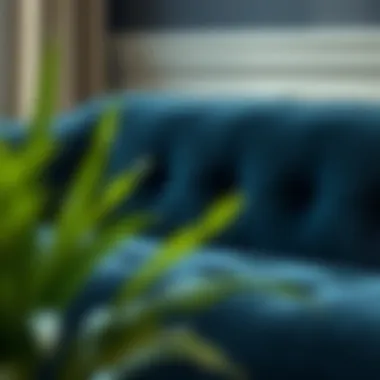
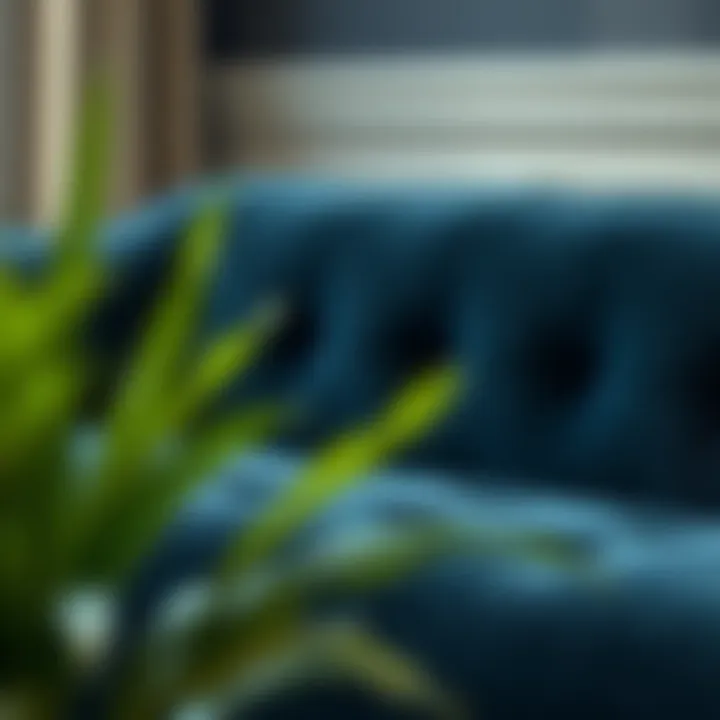
- Use a brush specifically meant for velvet or a soft toothbrush.
- Brush lightly to avoid damaging the fabric.
- Always follow the natural direction of the fibers.
By incorporating this step, not only do you enhance the fabric's visual appeal, but you also extend its lifespan.
Drying and Restoring Texture
Drying velvet properly is essential for its long-term care. If the fabric has been soaked during cleaning, it’s paramount to allow it to dry in a well-ventilated area away from direct sunlight or heat sources. Excessive heat can cause fibers to shrink or lose their soft texture.
If you're drying velvet cushions or garments, placing them flat on a clean, dry towel will supercharge the drying process, aiding in shape retention. Additionally, during this time, gently reshape any parts that may have twisted or sagged during cleaning.
Once the velvet is dry, restoring its texture can be performed by lightly steaming it with a handheld garment steamer. This will help remove any creases that may have developed. However, be cautious with the steaming process; too much moisture can ruin the aesthetics of the fabric. Always test a small, inconspicuous area before applying any steam directly.
In summary, effective post-cleaning care not only plays a vital role in restoring the beauty of your velvet but also protects it against future wear. By following these protocols, velvet can remain an exquisite addition to your home, retaining its rich colors, soft touch, and regal allure for all to admire.
Preventing Future Stains on Velvet
Preventing stains on velvet is an art in itself. Understanding how to maintain the luxurious nature of this fabric brings significant benefits, especially if you wish to keep its aesthetic appeal for years to come. Considering how easily velvet can attract dirt and absorb liquids, taking proactive measures is essential for homeowners and design aficionados alike. With this in mind, we can explore two main strategies for keeping your velvet in flawless condition: applying fabric protectors and committing to routine maintenance.
Applying Fabric Protectors
One of the most effective ways to stave off stains on velvet is by using a quality fabric protector. These invisible barriers offer valuable shielding against spills and smudges, buying you precious time to respond when accidents happen. Products containing Teflon or similar technologies work quite well for velvet. However, it's paramount to choose a protector suitable for the specific type of velvet fabric you have.
- Research: Before applying, take some time to search for reviews and recommendations tailored to your velvet type. Some protectors may not be compatible with certain dye processes.
- Testing: Always conduct a patch test in a hidden area to see how the fabric reacts; some treatments may cause discoloration.
- Application: Follow the manufacturer's instructions diligently. Generally, you'll want to spray an even coating from a distance to ensure uniform coverage without saturating the fabric. Remember to let it dry completely before using the furniture or garment again.
"An ounce of prevention is worth a pound of cure."
By using fabric protectors regularly, you'll increase the longevity of your velvet items, sparing yourself potential heartache down the line.
Routine Maintenance Tips
Just as a well-tended garden flourishes with regular care, so too does velvet require dedicated maintenance. Implementing a few simple habits into your routine can dramatically reduce the likelihood of stubborn stains forming in the first place.
- Dusting: Regularly dust your velvet upholstery or garments with a soft cloth or a gentle vacuum with a soft brush attachment. This action not only preserves the texture but also prevents dirt from settling into the fibers.
- Immediate Attention: Whenever you notice a spill, act quickly. Blot rather than scrub, and always use a clean, white cloth to avoid dye transfer.
- Steam Cleaning: Occasionally steam cleaning can refresh the pile of velvet, helping restore its lush feel while eliminating any lingering odors.
- Avoiding Direct Sunlight: Direct exposure to sunlight can bleach colors over time. Arrange furnishings in a way that minimizes this risk— curtains can help here, too.
Establishing such routines ultimately saves you both time and effort down the road. Folks who maintain their velvet fabrics not only enjoy their beauty longer but also cultivate a sense of satisfaction in upkeeping their home.
By understanding the nuances of fabric protection and diligent maintenance, homeowners and design lovers can truly appreciate the splendor of velvet, ensuring that it remains a shining star in their living spaces.
Potential Risks and Considerations
When it comes to velvet care, understanding potential risks and considerations can save a whole heap of trouble down the line. Velvet is a luxurious fabric, but it comes with its own set of challenges, especially when faced with stains. If not approached with care, cleaning efforts can do more harm than good, leading to faded colors or altered textures.
Understanding Fabric Sensitivity
Velvet, despite its resilience, is sensitive to certain cleaning agents and techniques. Using harsh chemicals can strip away the fabric's natural sheen, transforming a once-vibrant piece into a dull shadow of its former self. Gentle handling is key. For instance, you might want to avoid anything with bleach or strong alcohol content, as they can cause irreversible damage.
Here are some specific considerations when it comes to fabric sensitivity:
- Read Labels: Always check the care label on your velvet items for any specific cleaning instructions. Some types of velvet might require dry cleaning only, and ignoring this can ruin the fabric entirely.
- Spot Test: It’s wise to test any cleaning solution on a hidden area before applying it to the stain. This helps to avoid ugly surprises that arise from direct application on visible fabric.
- Avoid Excess Moisture: Too much water can distort the pile, leading to more groups rather than a smooth appearance. Stick to dabbing instead of soaking the fabric.
In essence, the sensitivity of velvet cannot be overstated. Treat it like a delicate flower, one wrong move and you can risk losing its beauty.
Limitations of Home Remedies
While many swear by home remedies for cleaning, it's essential to understand their limitations, particularly for something as delicate as velvet. Homemade solutions can often seem like a quick fix, but they aren’t universally effective and sometimes counterproductive.
Consider these points when trusting your homemade concoctions:
- Inconsistent Results: What works like a charm on one type of stain may fail miserably on another. The effectiveness of vinegar or baking soda varies based on the nature of the stain.
- Potential Residue: Ingredients like soap or detergent can leave behind a residue that attracts dirt over time, potentially worsening the situation.
- Over-Reliance on Traditional Wisdom: Grandma’s secret may not hold water. While old methods can provide guidance, remember that fabrics have evolved. Newer materials might not react in the same way as they used to.
Given these considerations, relying solely on home remedies might not be the best course of action. Instead, think of them as a compliment to professional cleaning techniques. Sometimes, leaving it to the experts is the way to go.
"Understanding the nuances of your fabric not only protects its integrity but also enriches its lifespan."
Culmination
In summation, the journey through the intricate world of velvet care has highlighted a few essential points worth reflecting upon. Maintaining the appearance and longevity of your velvet upholstery or garments is not merely a chore; it's an investment in both aesthetics and durability. Whether you are a homeowner seeking to ensure your living space remains chic or an interior design enthusiast passionate about fabric maintenance, understanding how to treat stains is fundamental.
Benefits of Mastering Stain Removal:
- Preservation of Aesthetics: Stains can quickly detract from the opulent look of velvet. Knowledge of how to remove different types of stains helps preserve its rich texture and elegant sheen.
- Cost-Efficiency: Rather than tossing stained items or frequently hiring professional cleaners, mastering stain removal can save you substantial amounts over time. Plus, you maintain your distinct personal touch in caring for your items.
- Sustainability: Proper care leads to less fabric waste, aligning with a more environmentally conscious lifestyle. When you are mindful of upkeep, it not only benefits your wallet but also reduces the ecological footprint of the fashion and furniture industries.
However, it's equally important to recognize the considerations that come with this knowledge. For instance, not all fabrics respond well to homemade cleaning solutions, and rigging up a remedy without proper knowledge could lead to disasters. This highlights the importance of testing products and knowing the fabric’s sensitivities before diving into cleaning tasks. Home remedies, though tempting, often have limitations that can surprise even seasoned homeowners.
Ultimately, care for velvet involves a delicate balance between proactive prevention and thoughtful action post-incident. It’s about nurturing those luxurious fibers so they can long remain the focal point of any room or outfit. By adopting the techniques and insights shared in this guide, you are better equipped to handle stains with confidence and competence—keeping your velvet looking its best for years to come.







